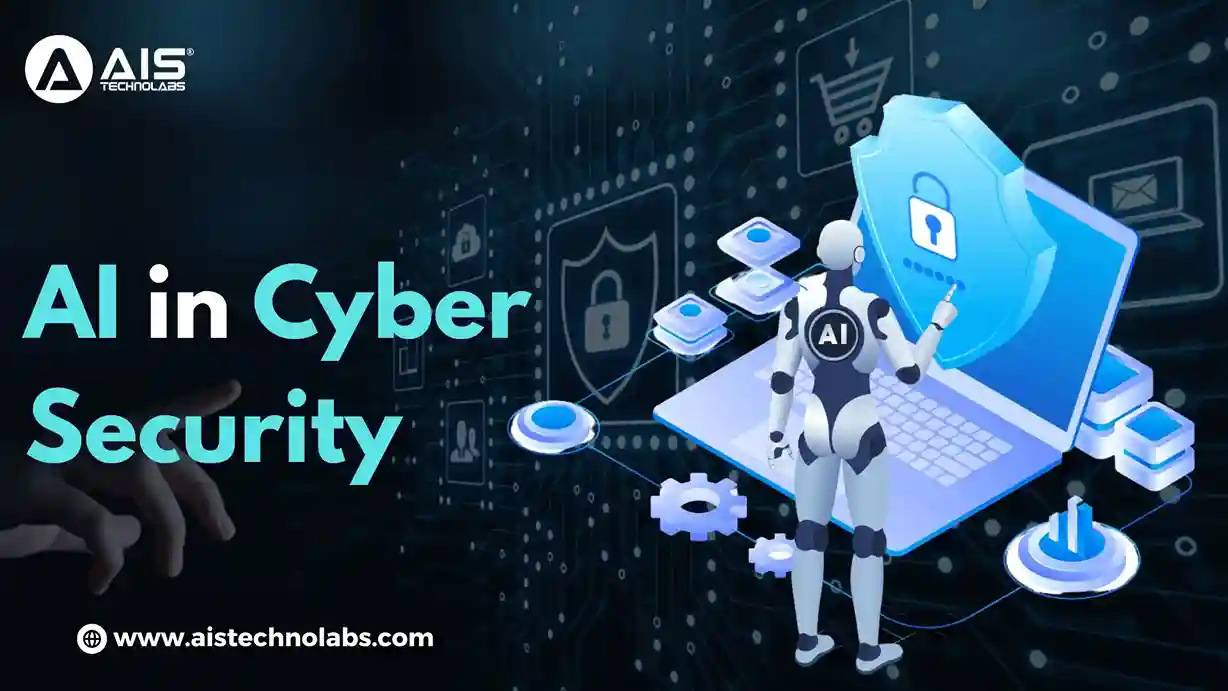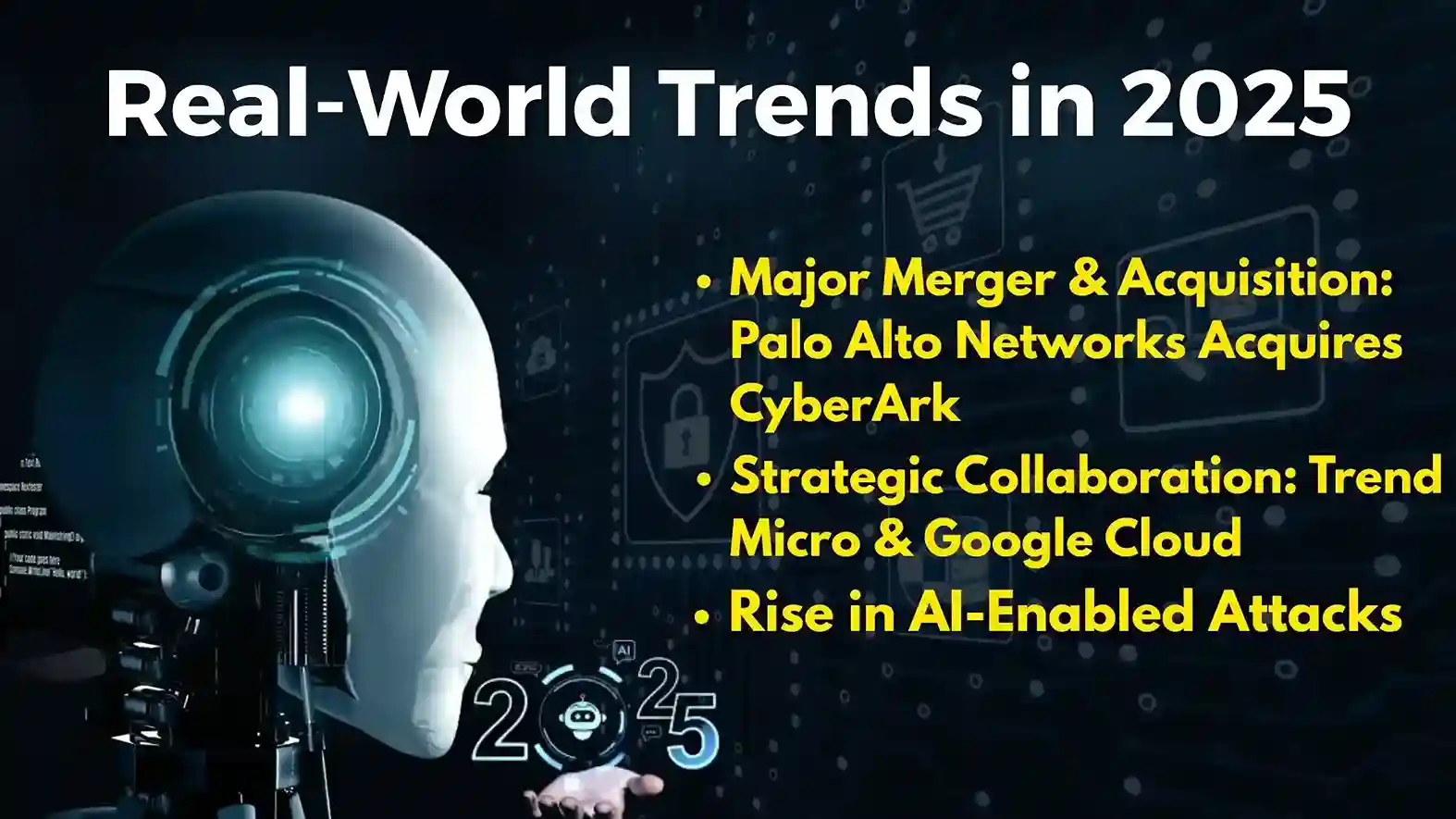Table of Content
(500 views)

Introduction
As we step into 2025, the landscape of cybersecurity has undergone a profound transformation. Traditional, reactive approaches that relied on scanning for known threats have given way to proactive, AI-driven security platforms designed to detect and neutralize emerging threats in real time. Today’s cyberattacks are faster, more sophisticated, and often powered by AI themselves, ranging from autonomous intrusion attempts and large-scale phishing campaigns to advanced identity-based exploits.
In response, leading Artificial Intelligence Companies are redefining how organizations defend their digital infrastructure. By leveraging advanced machine learning, behavioral analytics, and autonomous response mechanisms, these innovators are at the forefront of a new era in cybersecurity.
This blog will help you understand the evolving role of AI in cybersecurity, showcasing cutting-edge AI-powered security tools, emerging trends, and real-world examples that illustrate how AI is reshaping digital defense strategies in 2025.
What Is AI in Cybersecurity?
AI in cybersecurity refers to applying machine learning, deep learning, natural language processing (NLP), and agentic AI to strengthen digital defense systems. Unlike traditional systems that rely on static signatures, modern AI systems build baseline models of network traffic, user behavior, endpoint logs, and cloud infrastructure telemetry. When anomalies occur, AI flags them for further investigation or takes automated action—reducing dwell time, elevating priority, and alleviating pressure on human analysts (Wikipedia, arXiv, WIRED, Reuters, IT Pro).
This shift toward Automated Detection and Response (ADR) embodies the new frontier in software development and app development: platforms that respond in real time, learn from evolving patterns, and adapt dynamically to emerging threats (Security Curated, Pressmaverick).
The Role of AI-Powered Security Tools in 2025
In the rapidly evolving digital ecosystem of 2025, AI-powered security tools have become indispensable for modern enterprises. These tools go beyond traditional rule-based firewalls or antivirus software—they are intelligent, adaptive, and proactive in securing complex IT environments. Leading artificial intelligence companies are at the forefront of this transformation, offering integrated solutions that learn, adapt, and respond faster than any human team could manage on its own.
Here’s how these tools are reshaping cybersecurity:
Real-Time Anomaly Detection Across Endpoints, Networks, and Cloud Systems
AI-powered software, trained on vast datasets, now monitors thousands of endpoints, cloud containers, and network flows simultaneously. Artificial intelligence companies like Vectra AI and ReliaQuest use behavior-based detection rather than signature-based rules. This means they can catch zero-day threats, insider anomalies, and lateral movement across a network in real time—before damage occurs. These AI-powered systems learn “normal” behavior and flag deviations instantly, significantly improving response speed and accuracy.
Automated Triage and Investigation to Rank Threats by Severity
With the sheer volume of alerts generated daily, human analysts can suffer from alert fatigue. AI security platforms reduce this burden using machine learning to automatically prioritize threats. Solutions from companies like Deep Instinct apply predictive analysis to sort critical threats from benign anomalies. This triage ensures that human analysts focus only on high-impact incidents. Artificial intelligence companies are increasingly embedding autonomous triage engines into their platforms, reducing false positives by up to 90%.
Autonomous Containment and Remediation via XDR Platforms Modern Extended Detection and Response
(XDR) platforms now come equipped with AI agents that autonomously isolate infected endpoints, block malicious IP addresses, or roll back compromised sessions. AI-powered security tools from vendors like CrowdStrike and SentinelOne automatically contain attacks before they propagate. These solutions are often the result of cutting-edge innovations developed by artificial intelligence companies that blend cybersecurity with real-time automation and threat intelligence.
Intelligent Governance for AI Pipelines and Compliance Workflows
As organizations increasingly deploy their own AI models, the need for governance becomes crucial. Tools from OneTrust and BigID provide intelligent compliance automation, ensuring that data governance policies, GDPR/CCPA regulations, and AI model explainability standards are met. These platforms use AI to audit, document, and secure AI pipelines—helping enterprises avoid non-compliance. By leveraging AI for governance, artificial intelligence companies help bridge the gap between innovation and regulation.
Behavioral Analytics Powered by Agentic AI to Anticipate and Preempt Threats
2025 marks the rise of agentic AI—AI agents capable of taking initiative and learning on their own. Behavioral analytics platforms like Vectra Detect and Darktrace’s Immune System use these agents to analyze user behavior over time, detect abnormal access patterns, and anticipate threats before they occur. For instance, if a user’s login time, geolocation, or data access habits suddenly deviate from normal, the system can flag or block the session. These advancements are the result of major breakthroughs by artificial intelligence companies investing in self-learning and generative cyber defense models.
Securing Hybrid and Multi-Cloud Environments
With enterprises moving to hybrid cloud and multi-cloud architectures, securing data, apps, and APIs across disparate environments is a major challenge. AI-powered tools offer cloud-native security that integrates across platforms like AWS, Azure, and Google Cloud. Companies like Trend Micro and Palo Alto Networks are deploying AI to protect cloud workloads dynamically, making policy enforcement and threat monitoring seamless.
Artificial intelligence companies are enabling a new era where security is continuous, context-aware, and scalable across every environment—from edge devices to hyperscale cloud infrastructure.
Spotlight: Artificial Intelligence Companies Leading Cyber Defense
ReliaQuest
ReliaQuest’s GreyMatter platform uses agentic AI to detect, investigate, and respond to threats across enterprise environments. It offers response times of under five minutes, 30% greater accuracy, and processes alerts 20× faster than traditional methods.
Vectra AI
Vectra AI’s NDR/XDR solutions (Vectra Detect, Recall, Stream) analyze attacker behavior signals across network and cloud environments, using real-time AI to correlate and prioritize attack data—now rated in Gartner’s 2025 Magic Quadrant.
Deep Instinct
This company applies deep learning to prevent and detect malware and advanced persistent threats (APTs) at scale. Its deep-learning AI predicts attacks before they happen by identifying anomalous behavior in real time.
Anomali
Known for threat intelligence, Anomali now integrates NLP-based tools like Lens and Cloud-native XDR to automatically analyze structured and unstructured threat data, automating detection and response workflows globally.
Vastav.AI (India)
Designed in India, Vastav.AI specializes in real-time deepfake detection for video, image, and audio content. Launched in March 2025, it boasts 99% accuracy in identifying AI-generated media, helping combat misinformation and fraud in sectors like media and law enforcement.
Noma Security
This Israeli startup (raised $100M Series B in July 2025) focuses on securing AI agents themselves. Its platform monitors autonomous agents, sets guardrails, detects vulnerabilities, and ensures regulatory compliance—addressing the increasing risk of rogue AI systems.
OneTrust
Traditionally known for privacy and compliance tools, OneTrust now offers agentic AI features like OneTrust Copilot and automated breach-response workflows. It integrates with Azure OpenAI for AI governance throughout the model lifecycle.
Key Examples & Use Cases in 2025
A) Agentic AI Threat Detection & Automated Response
Companies like ReliaQuest, Vectra AI, Deep Instinct, and OneTrust utilize agentic AI and open XDR architectures to monitor and autonomously react to threats. This capability is critical as threat actors increasingly deploy AI to conduct phishing, credential stuffing, or reconnaissance, making human-only detection obsolete.
B) AI-driven Deepfake Detection
Platforms such as Vastav.AI showcase how AI can identify manipulated media—vital in 2025, when deepfake scams surged globally by over 3000% in 2023–2024. This has applications in media authentication, election integrity, and fraud detection.
C) Adaptive Phishing Defense with LLMs
Emerging tools like AdaPhish use LLMs and vector databases to automate phishing detection and anonymization, enabling adaptive, scalable protection while preserving privacy for security education and incident tracking in real time (arXiv).
D) Autonomous Penetration Testing by AI Agents
AI agents like RunSybil’s Sybil simulate attacker workflows—mapping sites, probing inputs, chaining vulnerabilities—to perform continuous, automated penetration testing. These AI-powered pen-test platforms offer “artificial intuition” beyond traditional scanners (WIRED).
Real-World Trends in 2025

The cybersecurity landscape in 2025 is being shaped by major strategic moves, high-impact collaborations, and increasingly sophisticated AI-enabled threats. These developments underscore the critical role that Artificial Intelligence Companies play in defending digital ecosystems at scale.
Major Merger & Acquisition: Palo Alto Networks Acquires CyberArk
In a landmark move, Palo Alto Networks finalized a $25 billion acquisition of CyberArk in July 2025. The acquisition significantly strengthens Palo Alto’s identity and access security capabilities by integrating CyberArk’s privileged access management solutions with AI-driven threat detection systems. This strategic alignment highlights the growing importance of AI-powered security tools as a core pillar of modern cybersecurity frameworks.
Strategic Collaboration: Trend Micro & Google Cloud
Trend Micro deepened its alliance with Google Cloud to enhance its flagship security platform, Vision One. By integrating Google’s advanced AI models, Trend Micro has boosted its ability to deliver real-time compliance monitoring, intelligent data protection, and machine learning–powered scam detection across complex, multi-cloud environments. This partnership illustrates how leading Artificial Intelligence Companies are combining cloud and AI innovations to tackle emerging cyber threats more efficiently.
Rise in AI-Enabled Attacks
Cybercriminals are also embracing AI—deploying AI chatbots to negotiate ransomware demands and leveraging automation for targeted phishing and system breaches. In a recent wave of attacks, over 400 SharePoint servers were compromised using AI-enhanced tactics. This surge in attacker sophistication has sparked a growing demand for AI-based threat hunting solutions, such as Nebulock, a rising platform backed by Bain Capital. The increasing complexity of threats reinforces the urgent need for AI-driven, adaptive cybersecurity strategies.
Challenges & Ethical Considerations
- Model transparency and explainability: With agentic AI tools autonomously acting, tracing decisions is harder. Platforms like OneTrust now offer governance over AI workflows.
- Adversarial AI: Attackers use agentic AI to automate breaches, impersonate users, or bypass CAPTCHAs—ChatGPT’s agent has already outsmarted a CAPTCHA test, raising alarms about verification systems’ obsolescence (timesofindia.indiatimes.com).
- Data bias and privacy: Automated tools that analyze user behavior must avoid bias and respect confidentiality. Robust policy frameworks and fine-tuned datasets remain crucial.
- AI arms race: Nations and groups are running competing AI-powered cyber tools. Policymakers are responding with chip export controls (e.g. U.S. chip export rules to China), but firms like Huawei are racing to build self-reliant AI stacks (Reuters).
The Future Outlook: What’s Coming Next
Looking beyond mid-2025, the outlook for AI in cybersecurity continues to accelerate:
- Bridging AI with green cloud computing: As cloud blogs show for green initiatives, more security platforms will leverage sustainable AI inference in cloud environments to reduce cost and carbon footprint.
- Convergence of privacy, governance, and security: Tools like OneTrust Copilot model how compliance, privacy, and AI oversight can unify in modern cybersecurity workflows.
- Investor momentum: With cybersecurity projected to grow from $15 billion in 2021 to over $135 billion by 2030, AI-powered security firms remain central to investment strategies (Investors).
Conclusion
In 2025, AI-powered security tools are no longer optional—they are mission-critical defenses. The rise of Artificial Intelligence Companies like ReliaQuest, Vectra AI, Deep Instinct, Anomali, and emerging players like Vastav.AI and Noma Security demonstrates how widely AI is being woven into detection, response, governance, and threat intelligence.
These companies exemplify the modern landscape of AI in cybersecurity: real-time, agent-based, adaptive, and intelligent. As threats evolve—deepfakes, rogue AI agents, negotiation bots, and state-level cyber warfare—the collaboration between AI innovators like AIS Technolabs and cybersecurity firms will shape the future of digital defense.
By 2025 and beyond, AI-powered platforms offer faster threat detection, reduced analyst fatigue, proactive security models, and cloud-native scalability. But with great power comes great responsibility: ensuring transparency, privacy, bias mitigation, and governance will define who leads in the AI-cybersecurity next frontier.
FAQs
Ans.
AI is not replacing jobs but is shifting roles. Professionals are now expected to manage and interpret AI security tools, focusing on high-level strategy and incident response rather than manual tasks.
Ans.
Yes. The market offers many affordable, AI-as-a-service (AIaaS) and cloud-based security products with built-in AI, making advanced protection accessible without a large budget or specialized team.
Ans.
The primary concerns are data privacy, potential bias in AI models, and the accountability of automated decisions made by AI systems in critical security situations.
Ans.
The future of AI in cybersecurity is real-time detection, automated response, and smarter threat prevention. AI-powered security solutions like those from AIS Technolabs will drive faster, more accurate cyber protection across all digital environments.